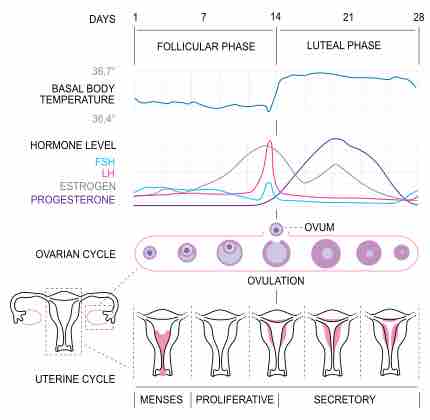The menstrual cycle is the physiological change that occurs under the control of the endocrine system in fertile women for the purposes of sexual reproduction and fertilization.

The Menstrual Cycle
The menstrual cycle is controlled by the endocrine system, with distinct phases correlated to changes in hormone concentrations.
Phases of the Menstrual Cycle
The menstrual cycle is divided into three stages: follicular phase, ovulation, and the luteal phase.
Follicular Phase
During the follicular phase (or proliferative phase), follicles in the ovary mature under the control of estradiol. Follicle-stimulating hormone (FSH) is secreted by the anterior pituitary gland beginning in the last few days of the previous menstrual cycle. Levels of FSH peak during the first week of the follicular phase. The rise in FSH recruits tertiary-stage ovarian follicles (antral follicles) for entry into the menstrual cycle.
Follicle-stimulating hormone induces the proliferation of granulosa cells in the developing follicles and the expression of luteinizing hormone (LH) receptors on these cells. Under the influence of FSH, granulosa cells begin estrogen secretion. This increased level of estrogen stimulates production of gonadotropin-releasing hormone (GnRH), which increases production of LH. LH induces androgen synthesis by theca cells, stimulates proliferation and differentiation, and increases LH receptor expression on granulosa cells.
Throughout the entire follicular phase, rising estrogen levels in the blood stimulate growth of the endometrium and myometrium of the uterus. This also causes endometrial cells to produce receptors for progesterone, which helps prime the endometrium to the late proliferative phase and the luteal phase. Two or three days before LH levels begin to increase, one or occasionally two of the recruited follicles emerge as dominant. Many endocrinologists believe that the estrogen secretion of the dominant follicle lowers the levels of LH and FSH, leading to the atresia (death) of most of the other recruited follicles. Estrogen levels will continue to increase for several days.
High estrogen levels initiate the formation of a new layer of endometrium in the uterus, the proliferative endometrium. Crypts in the cervix are stimulated to produce fertile cervical mucus that reduces the acidity of the vagina, creating a more hospitable environment for sperm. In addition, basal body temperature may lower slightly under the influence of high estrogen levels.
Ovulation
Estrogen levels are highest right before the LH surge begins. The short-term drop in steroid hormones between the beginning of the LH surge and ovulation may cause mid-cycle spotting or bleeding. Under the influence of the preovulatory LH surge, the first meiotic division of the oocytes is completed. The surge also initiates luteinization of theca and granulosa cells. Ovulation normally occurs 30 (± 2) hours after the beginning of the LH surge.
Ovulation is the process in a female's menstrual cycle by which a mature ovarian follicle ruptures and discharges an ovum (oocyte). The time immediately surrounding ovulation is referred to as the ovulatory phase or the periovulatory period. In the preovulatory phase of the menstrual cycle, the ovarian follicle undergoes cumulus expansion stimulated by FSH. The ovum then leaves the follicle through the formed stigma. Ovulation is triggered by a spike in the amount of FSH and LH released from the pituitary gland.
Luteal Phase
The luteal phase begins with the formation of the corpus luteum stimulated by FSH and LH and ends in either pregnancy or luteolysis. The main hormone associated with this stage is progesterone, which is produced by the growing corpus luteum and is significantly higher during the luteal phase than other phases of the cycle. Progesterone plays a vital role in making the endometrium receptive to implantation of the blastocyst and supportive of the early pregnancy. It also raises the woman's basal body temperature.
Several days after ovulation, the increasing amount of estrogen produced by the corpus luteum may cause one or two days of fertile cervical mucus, lower basal body temperatures, or both. This is known as a secondary estrogen surge. The hormones produced by the corpus luteum suppress production of the FSH and LH, which leads to its atrophy. The death of the corpus luteum results in falling levels of progesterone and estrogen, which triggers the end of the luteal phase. Increased levels of FSH start recruiting follicles for the next cycle.
Alternatively, the loss of the corpus luteum can be prevented by implantation of an embryo: after implantation, human embryos produce human chorionic gonadotropin (hCG). Human chorionic gonadotropin is structurally similar to LH and can preserve the corpus luteum. Because the hormone is unique to the embryo, most pregnancy tests look for the presence of hCG. If implantation occurs, the corpus luteum will continue to produce progesterone (and maintain high basal body temperatures) for eight to 12 weeks, after which the placenta takes over this function.